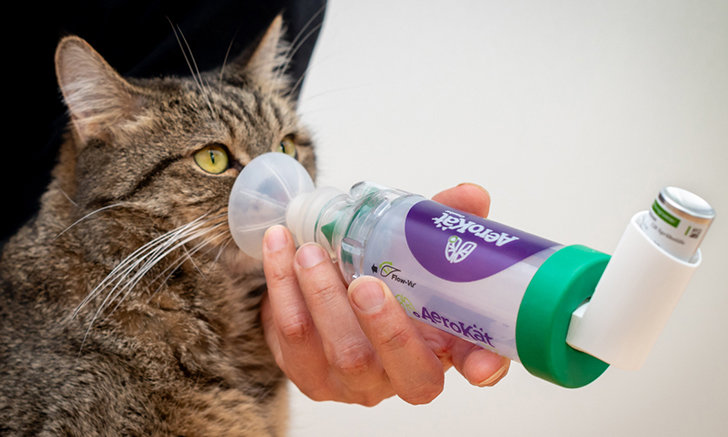Allergy in cats

Environmental Problems
Allergies

Introduction:
As with humans, allergies have become a very common problem in our pets. Environmental hazards and stress caused by urban lifestyles can reduce the immune response of our animals, which in turn can make them react more intensely to some of the normal environmental factors (i.e. hypersensitivity reactions).
Allergy Types:
The most common allergy in animals is atopy, which is caused by the inhalation of different pollens and most often causes pruritus, allergic ear inflammation, allergic conjunctivitis, but may also cause allergic bronchitis and even asthmatic symptoms.
Food allergies, usually to the protein source in the diet, are also common, which can cause leg/feet chewing, oral and/or anal pruritus, occasional digestive issues, or diarrhea.
Often we see allergic dermatitis caused by fleas (Flea Allergic Dermatitis) when the animal reacts to the foreign proteins in the fleas' saliva which causes severe itching over the entire body.
Allergic dermatitis may also develop in localized areas, called hot spots, that are usually associated with hot summer days (and sometimes FAD) and appear as burning itchy patches on the outer legs.
A common problem is the allergic symptoms caused by the secretion of the anal glands, which can not only cause itching of the buttocks but allergic ear inflammation as well.
We may also encounter contact allergies when direct contact with an allergen causes a local skin rash, most commonly seen on the abdomen from blankets made of synthetic fibres or metal bowls causing an allergic reaction around the mouth.
The allergic symptoms listed above generally develop over a few days or period of several weeks, but sudden reactions also occur and are generally caused by insect bites, certain medications, or even vaccines. In cases of sudden allergic reactions, such as vaccine reactions, it is important to contact your veterinarian to quickly remedy the symptoms.
Allergy Symptoms:
Depending on the type of allergy, various allergic symptoms can develop. The most common allergies seen are of the skin so pruritus, scratching and chewing (and resulting damaged coat condition) as well as secondary bacterial or fungal skin infections are typical. The skin of the outer ear canal is particularly sensitive, so allergic ear inflammation is also very common causing redness, burning, itchiness, and discharge. In cases of allergic conjunctivitis we see bloodshot conjunctiva, watery eyes, and secondary serous nasal discharge as well. In the case of seasonal allergies, which typically emerge at the onset of pollen season, allergic rhinitis, serous nasal discharge, sneezing, inflammation, allergic tracheal bronchitis, and cough are common symptoms. Hypersensitivity reactions are characterized by a sudden onset of itchy eyes, lips, skin swelling, itching all over the body, malaise, or vomiting.
Allergy Diagnostics:
Determining the exact type of allergy is not always an easy task, as each type of allergy can coexist, and the secondary symptoms may mask the underlying problem. Fortunately, following the example of human allergology, veterinary allergy diagnosis has improved a lot in recent years so that today it is possible for complete, accurate, and specific allergen detection, alongside treatment on an empirical basis. This can be done with a skin allergy testing, but there is also a possibility for blood tests to demonstrate more allergic parameters, when a solution can be made based on the allergens.
Allergy Treatment:
After a precise diagnosis (i.e. according to the type of allergy) a variety of treatments are possible. Elimination of the allergen (e.g. removal of fleas with FAD, or changing diet with food allergies) is most important and should be done whenever possible. In recent years, this area has grown a lot, so the side effects of treatment drugs have been reduced, topical treatments have been developed, foods have been developed specifically for food allergies and many supplemental treatments (e.g. homeopathy) have been made available. It is also possible to treat serious allergic symptoms with custom serums based on the allergens affecting the patient.
Asthma

Introduction:
Allergy induced lower respiratory inflammation is called asthma. Most often it is caused by inhaled house dust or pollens which trigger a hypersensitivity reaction of the bronchial wall, creating allergic inflammation. The walls of the bronchi thicken and increased production of mucus develops causing the bronchial cavity can be significantly narrowed. This is very common in cats!
Symptoms:
The most common symptoms are coughing fits and shortness of breath. It is also possible to have other allergy symptoms, most often pruritus.
Diagnosis:
Asthma is usually diagnosed with chest radiographs, but airway endoscopy and sampling may also be necessary.
Treatment:
Human inhalers are not feasible in animals, so general anti-allergy treatment should be initiated along with an antitussive and expectorant.
